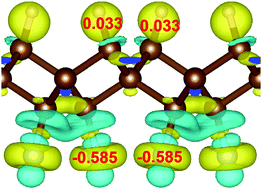Piezoelectric and polarized enhancement by hydrofluorination of penta-graphene
Abstract
Motivated by the challenges in the harnessing of energy and the continuing trend of miniaturizing devices, an exhaustive evaluation of the electronic, mechanical and piezoelectric properties of surface modified penta-graphene (PG), including fluorinated PG (F-PG-F), hydrofluorinated PG (H-PG-F) and hydrogenated PG (H-PG-H), was carried out via a first-principles approach based on density functional theory. We first predicted the H-PG-F system and calculated its phonon dispersion and magnetic properties. All three systems were found to exhibit an e31 piezoelectric effect, and the e31 (96.88 pC m−1) effect of H-PG-F was found to be much greater than that of the other two systems. So, it could be concluded that hydrofluorination can significantly enhance the piezoelectric properties of PG. The binding energy and formation energy of the H-PG-F system were found to be the lowest among the three surface modified PG systems, showing that the H-PG-F system is the most energetically favorable state. The e31 piezoelectricity can be potentially engineered into a PG monolayer by surface modification, providing an avenue for monolithic integration of electronic and electromechanical devices with a PG monolayer for use in mechanical stress-sensors, nano-sized actuators and energy harvesting systems. The H-PG-F system stands out in terms of its combination of a larger piezoelectric coefficient (e31 = 96.88 pC m−1), negative Poisson's ratio and low formation energy (−3.37 eV) and is recommended for experimental exploration.

- This article is part of the themed collection: 2018 PCCP HOT Articles


 Please wait while we load your content...
Please wait while we load your content...